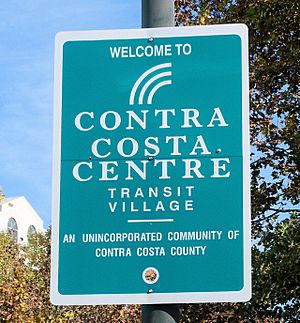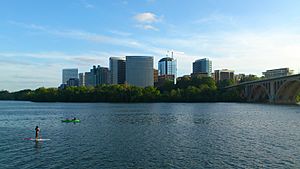Unincorporated area facts for kids

An unincorporated area is a place that is not part of a city or town. This means it doesn't have its own local government, like a city council, to make rules and provide services. Instead, a larger government, like a county or province, usually takes care of things. You can find many unincorporated communities in countries like the United States and Canada.
Contents
Understanding Unincorporated Areas
Imagine living in a place that isn't officially a city or a town. That's an unincorporated area! These places don't have their own local government, like a mayor or a city council. Instead, a larger government, often a county or a province, is in charge. This larger government provides services like roads, police, and fire protection.
Sometimes, an unincorporated area might be a small village or a group of houses. Other times, it can be a huge area of forests, lakes, or even military training grounds with very few people.
Unincorporated Areas Around the World
Many countries have areas that are not part of a city or town. Let's look at some examples:
Australia
In Australia, most places are part of a local government area. But some very remote or less populated areas are unincorporated. This means they are directly managed by the state or territory government. Even in these areas, postal addresses still use local names, so mail delivery is clear.
Canada
In Canada, an unincorporated settlement doesn't have its own city council. These places can be small villages called hamlets, or even large areas that feel like a city. For example, Fort McMurray in Alberta is a very large unincorporated area, but it's managed by a larger regional government.
Sometimes, large wild areas are "unorganized." This means the provincial government directly controls them. Some unincorporated places might get services from special groups, like a local services board in Ontario.
Czech Republic
Almost all of the Czech Republic is divided into municipalities (like cities or towns). The only exceptions are four military training areas. These areas are managed by military offices, not by local councils. They have very few or no regular people living there.
Denmark
The small group of islands called Ertholmene is the only part of Denmark that is not part of a municipality. These islands have been under military control since 1685. They are a protected cultural heritage site and have fewer than 100 people living there.
Germany
Germany has very few unincorporated areas, called gemeindefreie Gebiete. Most of these are uninhabited forests, lakes, or military training areas. As of 2007, there were only three inhabited unincorporated areas, all serving as military training grounds, with very few people living in them.
Largest Unincorporated Areas in Germany
Here are some of the largest unincorporated areas in Germany (not including lakes):
- Harz (Landkreis Goslar) (Lower Saxony): 371.76 km²
- Harz (Landkreis Göttingen) (Lower Saxony): 267.35 km²
- Gutsbezirk Reinhardswald (Hessen): 182.58 km²
- Osterheide (Lower Saxony): 177.99 km² (762 people in 2010)
- Solling (Lower Saxony): 177.49 km²
- Lohheide (Lower Saxony): 91.32 km² (716 people in 2010)
- Gutsbezirk Spessart (Hessen): 89.30 km²
- Ettaler Forst (Bavaria): 83.46 km²
- Gutsbezirk Münsingen (Baden-Württemberg): 64.68 km² (160 people in 2010)
- Sachsenwald (Schleswig-Holstein): 58.49 km²
- Veldensteiner Forst (Bavaria): 55.60 km²
- Göhrde (Lower Saxony): 51.81 km²
- Gartow (Lower Saxony): 50.92 km²
- Gutsbezirk Kaufunger Wald (Hessen): 50.32 km²
Israel
In Israel, almost all land is part of a municipality (city, local council, or regional council). However, a few unincorporated areas exist. These are often places of national importance, like Ben Gurion Airport, so that local decisions don't affect their operations.
The largest unincorporated area is a region in the Negev desert. Some Bedouin communities there are "unrecognized" because they are not part of a municipality, meaning they don't receive municipal services.
Netherlands
The Netherlands used to have unincorporated land when new land was created by draining water (called polders). These new areas were managed by a special officer until they were ready to become part of a municipality. Since 1996, the Netherlands no longer has any unincorporated land areas.
New Zealand
Most of New Zealand's small, distant islands are not part of any local region or district. They are called "Areas Outside Territorial Authority" and are managed directly by the national government. The Chatham Islands are an exception, as they have their own local government.
Norway
Norway's distant islands like Bouvet Island, Jan Mayen, and Svalbard are outside of any county or municipality. They are directly controlled by the national government. Svalbard has a governor who manages the area, while Jan Mayen and Bouvet Island have very few or no permanent residents.
United States
In the United States, an unincorporated area is usually the part of a county that is not inside any city or town. An unincorporated community is a place with a shared identity but no official city or town government.
There are two main types:
- A community that is part of a larger city or town, but not a separate city itself. For example, Hyannis, Massachusetts, is an unincorporated village within the town of Barnstable.
- A community that is completely outside any city or town government. Examples include Hovland, Minnesota and Nutbush, Tennessee.
Most states allow counties to have similar powers in unincorporated areas as cities have in their own areas. Some states use "townships" to manage these areas.
States differ a lot. In some northeastern states like New Jersey and New York, almost all land is part of an incorporated area. In New England, local governments are called "towns" or "cities."

On the other hand, states like Virginia have "strong counties." This means counties have broad powers, so there's less need for areas to become separate cities. This leads to large urban areas that are still unincorporated.
Some big cities have taken over all the unincorporated areas around them, creating "consolidated city-county" governments, like Jacksonville, Florida.
U.S. Census Bureau Information
The United States Census Bureau defines some unincorporated communities as "census-designated places" (CDPs). These are areas used for collecting statistics, but they don't have any legal government status. They often include an unincorporated community and the surrounding countryside.
The Census Bureau also calls some unincorporated areas "unorganized territories." These are parts of counties that are not included in any local government division. They exist in 10 states, mostly in the Midwest and Northeast. For example, in 2000, South Dakota had the most unorganized territories. The largest unorganized territory by population was Camp Lejeune, North Carolina, a military base.
U.S. Mail Delivery
Many unincorporated communities are recognized by the United States Postal Service (USPS) for mailing addresses. Some even have their own post offices. However, mailing addresses don't always change if an area becomes incorporated or disincorporated. The USPS sets ZIP codes to make mail delivery efficient, not to show government boundaries.
For example, Sandy Springs is a very populated place. Even after it became a city in 2005, "Atlanta" was still the default mailing address for a while because it was served by an Atlanta post office branch.
Populated Place Definition
The United States Geological Survey defines unincorporated areas with permanent populations as "populated places." These are areas with buildings and people, but they don't have official legal boundaries.
Countries Without Unincorporated Areas
Many countries, especially those with a long history of local government, do not have unincorporated areas. This means every piece of land belongs to a city, town, or other local government unit.
Some of these countries include:
- Albania
- Austria
- Belgium
- Bosnia and Herzegovina
- Brazil
- Chile
- China (Mainland)
- Colombia
- Croatia
- Estonia
- Finland
- France (except for Clipperton Island)
- Greece
- Indonesia
- Italy
- Japan (except for a few small islands)
- Lithuania
- Mexico
- Montenegro
- The Netherlands
- Peru
- The Philippines
- Poland
- Portugal
- Serbia
- Slovenia
- South Africa
- South Korea
- Sweden
- Taiwan
- The United Kingdom
See also
 In Spanish: Área no incorporada para niños
In Spanish: Área no incorporada para niños


